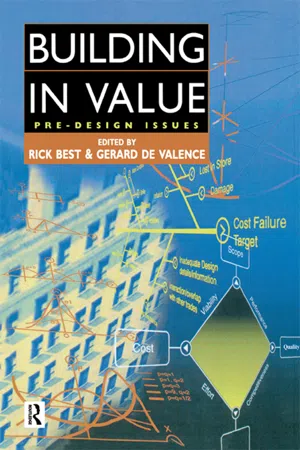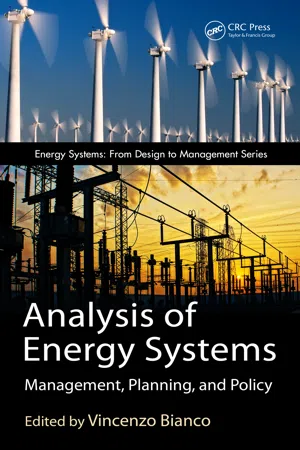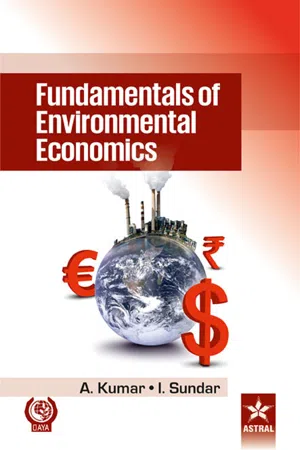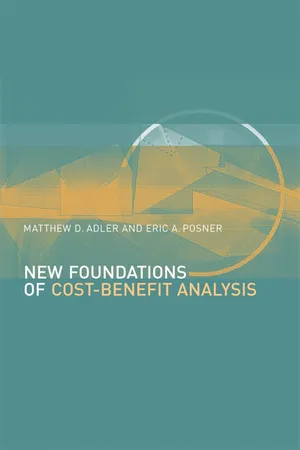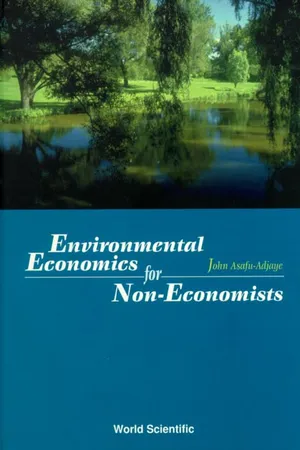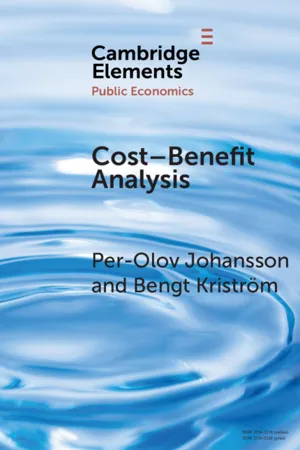Economics
Cost-Benefit Analysis
Cost-Benefit Analysis is a systematic approach used to evaluate the potential costs and benefits of a decision, project, or policy. It involves comparing the total expected costs against the total expected benefits to determine whether the benefits outweigh the costs. This analysis helps in making informed decisions by quantifying and comparing the positive and negative aspects of different options.
Written by Perlego with AI-assistance
Related key terms
1 of 5
12 Key excerpts on "Cost-Benefit Analysis"
- eBook - ePub
- Rick Best, Gerard de Valence, Rick Best, Gerard de Valence(Authors)
- 2013(Publication Date)
- Routledge(Publisher)
10 Cost or benefit?Grace Ding†DOI: 10.4324/9780080500416-10Editorial commentCost-Benefit Analysis (CBA) is generally associated with the selection of alternative developments or projects that are competing for limited or scarce resources. The most common use of CBA is in the selection of publicly funded projects where many possible uses of funds from government budgets exist but such funds are strictly limited and their use is subject to public scrutiny. The selection of those projects that are to proceed requires the use of some systematic method of appraising the competing alternatives and choosing those which provide the greatest benefits to the community – in other words, choosing the alternatives that will produce the best value for money.While CBA is usually applied to projects such as highways, bridges and similar infrastructure improvements, it has been included here as its fundamental purpose is to identify projects that will provide maximum value in return for the consumption of resources. These resources may be purely financial, but for many large projects the resources may include both tangible resources such as land and materials, or intangibles such as air quality or a quiet environment.The basic techniques of Cost-Benefit Analysis can also be applied to the evaluation of individual building projects as there are nearly always alternatives to constructing a new building, such as outsourcing or refurbishment or reengineering a process, which may be shown to be preferable if properly evaluated. If a new building is the appropriate solution to the client’s needs then there will be alternative designs which will need to be assessed if the most cost-effective solution is to be pursued. - No longer available |Learn more
Valuing Forest Ecosystem Services
A Training Manual for Planners and Project Developers
- Food and Agriculture Organization (FAO)(Author)
- 2019(Publication Date)
- United Nations(Publisher)
29 Module 3 The basics of cost–benefit analysis KEY MESSAGES • Making good decisions requires the ability to evaluate policy/project scenarios using meaningful units of measurement that enable comparisons among the various costs and benefits over time. • The concept of the “time value of money” is that the same amount of money may have different values depending on when it is available for consumption. Money now may be worth more than in the future because the future is uncertain and because we expect to earn more in the future. Discounting is a procedure to enable the comparison of values occurring at different times. • Financial and economic analyses enable us to assess the economic feasibility of a project and to judge efficiency in the allocation of resources. • Financial analysis considers market prices, and economic analysis also takes into consideration values that are not marketed (e.g. the costs and benefits associated with water pollution, biodiversity loss, changes in air quality, and soil protection). • Cost–benefit analysis (CBA) is a methodological tool for performing financial and economic analyses of projects or investments based on an analysis of the associated costs and benefits. In particular, CBA uses discounted cashflows to calculate profitability and risk indicators that allow the assessment of single investments as well as comparisons of alternative investment options. • Profitability indicators include the net present value, benefit/cost ratio and internal rate of return. The payback period is used as a risk indicator. Risks and uncertainties associated with CBA can also be addressed through sensitivity analyses that check how CBA results vary when variables (e.g. certain costs and benefits, and discount rates) change. • The choice of discount rate is crucial because it can significantly affect the CBA. - eBook - PDF
- Thomas E. Getzen, Jennifer Moore(Authors)
- 2012(Publication Date)
- Wiley(Publisher)
3 COST–BENEFIT AND COST-EFFECTIVENESS ANALYSIS Making the Most of Limited Funds Starting Point Go to www.wiley.com/college/getzen to assess your knowledge of cost–benefit analysis and cost-effectiveness analysis. Determine where you need to concentrate your effort. What You’ll Learn in This Chapter ▲ How to use cost–benefit analysis (CBA) as a means of determining the best use of limited funds ▲ What the three major types of medical benefits are and how they are valued ▲ What the four major types of medical costs are and how they are valued ▲ How economists measure the value people place on life ▲ The importance of perspective when conducting a CBA After Studying This Chapter, You’ll Be Able To ▲ Formulate health policy decisions, using CBA ▲ Assess the opportunity costs of policy decisions ▲ Calculate the expected value of uncertain benefits ▲ Evaluate potential benefits of a policy decision ▲ Evaluate potential costs of a policy decision 48 COST–BENEFIT AND COST-EFFECTIVENESS ANALYSIS INTRODUCTION Health economist Bengt Jönssen said that the purpose of health economics is to save lives. He was referring specifically to the use of economic evaluation tools to determine the most appropriate allocation of resources to health and among competing health applications. The tools of the health economist for this pur- pose are primarily cost–benefit analysis (CBA) and cost-effectiveness analysis (CEA). CBA comes closest to replicating the logic of the market, by considering a potential use of resources and asking, “Is this worth what it costs?” Unless the decision is necessarily “all or nothing,” CBA is also used to answer “How much is enough?” To undertake a CBA, you must first know the value of costs and the bene- fits. The economic concepts of opportunity cost and marginal analysis come into play. The appropriate measure of economic cost is opportunity cost, determined by the highest-valued alternative given up when a decision is made. - eBook - ePub
Analysis of Energy Systems
Management, Planning and Policy
- Vincenzo Bianco(Author)
- 2017(Publication Date)
- CRC Press(Publisher)
CBA is not the only example of economic tools applied to energy policy-making. Since the 1960s, the impact of energy policy measures has been assessed within the framework of various appraisal and evaluation tools. Decision analysis, environmental impact assessment, and strategic environmental assessment are all notable examples of appraisal tools predating and alternatives to CBA in the assessment of energy policies, programs, and projects. This chapter provides an overview not only of CBA but also of other appraisal and evaluation tools that have been historically applied to assess the impacts of energy policies, programs, and projects. It focuses on the types of data and models that typically inform CBAs for energy policies, the organizations involved, and issues of data exchange between energy companies and policy-makers. It is concluded that the technical and economic analyses underpinning CBAs on energy policy and regulation vary significantly depending on the type of policy, institutional aspects of decision-making, and availability of data.Keywords: Cost–benefit analysis, energy economics, energy policy8.1Introducing Cost–Benefit Analysis
Over the past three decades, cost–benefit analysis (CBA) has been applied to various areas of public policies and projects, including energy. Research on CBA varies significantly and can be classified into two wide areas of work:- Studies that have attempted to define the technical–economic reasons underpinning CBA
- Studies that carried out empirical evaluations over the performance of samples of CBA
From a theoretical point of view, CBA has been seen as a tool to increase the quality of regulation and public policy through welfare economics principles and Pareto efficiency. CBA in theory allows for the improvement of social and environmental conditions based on empirical evidence (Koopmans et al., 1964; Sunstein, 2002) while improving market competitiveness (Viscusi et al., 1987).Empirical studies on CBA have focused on the choice of discount rate (Dasgupta, 2008; Gollier, 2002; Lind, 1995; Viscusi, 2007), the integration of distributional principles (Adler and Posner, 1999), the choice of data sets (Hahn and Litan, 2005; Morral, 1986), the performance of different methodologies for monetizing benefits, and costs in cases where a market value does not exist (Sunstein, 2004; Viscusi, 1988). The latter point is of particular interest given the distance between theory and practice and deserves further reflection. - eBook - ePub
Community Impact Evaluation
Principles And Practice
- Nathaniel Lichfield(Author)
- 2005(Publication Date)
- Routledge(Publisher)
Cost-Benefit Analysis overcame the financial limitation by applying itself to economic costs and benefits. Traditional CBA continued the limitation of application to particular promoters, even though on the benefit side (e.g. in transportation) it was indirect rather than direct outputs that were taken into account. But it failed to recognize the diffused nature of the costs and benefits when seen from the community viewpoint; highway Cost-Benefit Analysis concentrates on benefits from using the road itself, rather than from the trip that is made (Lichfield 1987). And, although social Cost-Benefit Analysis did recognize the role of more than one promoter (as, for example, investment in rail transport taking account of repercussions on other modes; Beesley & Foster 1965), it was still limited in the wider community sense. Being primarily economic analysis, traditional CBA was reluctant to spread to non-economic inputs and outputs, and it tended to push aside those coming under the category of, for example, social, environmental and cultural. It was thus over-discriminating in terms of which costs and benefits. This discrimination was reinforced by the proclivity amongst economists to deal only with phenomena that could be valued (i.e. measured in terms of actual or simulated price) in order to introduce the undoubted richness that economics can offer: the capacity for sophisticated handling of apples and pears in the one set of equations. This led to the Intangibles and Incommensurables being treated separately in the analysis, which relegated them to a subsidiary place as secondary benefits and costs, so tending to leave them ignored or underplayed in the decision-taking process. And, although this proclivity has had the most valuable effect of stimulating investigation of more and more ingenious methods of estimating the value of benefits that are not recorded in the market process (Sinden & Worrell 1979, Nijkamp et al. 1986, Pearce et al. 1989, Pearce et al - eBook - PDF
- Colin Price(Author)
- 2017(Publication Date)
- Palgrave Macmillan(Publisher)
There is no official, widely accepted definition. This one, derived originally from an untraced source, displays the ambitiousness of the process. The most distinctive part is “in so far as possible measured in a common unit of account”. That defines CBA’s approach to combining different effects. What humane person could want a different valuation framework? Often it is said that “the trouble with CBA is that it can’t deal with [some specified decision or valuation problem] because CBA is …”—and there follows a definition of something which is not CBA. CBA is not of its nature materialistic; it is not marketist; it is not short-termist; it is not even necessarily anthropocentric, and certainly not more so than other modes of practical decision making. Because of its ambitious claim to incorporate all the effects of a change, it is subject to severe and sustained criticism, reviewed in Chap. 9. Enthusiasts for CBA are so, not because they think it faultless (practitioners know more of its real limitations than do those who criti- cise from outside), but because alternative processes of decision making seem even faultier, a matter also addressed in Chap. 9. Much of the following account draws on discussion in the 1970s, when the topic was under intensive development (Little and Mirrlees 1974; Squire and van der Tak 1975; Mishan 1988). Later texts (Hanley and Spash 1993; Pearce et al. 2006; Johansson and Kriström 2015) present a similar account of the theory, and treat practical topics as discussed in Chaps. 11, 12, 13 and 16. Origins and Applications of Cost–Benefit Analysis Far from being a recent technique, CBA dates from the C19th, arguably earlier. It derives from calculations of cost and revenue underlying day- to-day investment appraisal. 8 Cost–Benefit Analysis and Willingness to Pay for Landscape 135 Dupuit (1844) broadened the measure of benefit. - eBook - PDF
- Kumar, A(Authors)
- 2021(Publication Date)
- Daya Publishing House(Publisher)
Chapter 9 Cost–Benefit Analysis Economics can be derived into two areas of positive and normative economics. Positive economics attempts to explain and predict actual economic activity, aiming at the representation of the ‘facts’ without judging their contribution to the economic development. In contrast, normative economics explicitly introduces value judgments focusing on the efficiency evaluation of each investment project. Economic appraisal techniques aim to indicate policy makers which options are ‘better’ and such a process falls firmly in normative economics. Cost-Benefit Analysis provides the answer to the normative approach for the definition of economic impacts related to environmental investments and policies. In a close and detailed examination of Cost-Benefit Analysis we investigate whether an investment project or an environmental policy, contributes to social prosperity. An action or policy is considered solvent if the net social benefits counterbalance the respective net social cost. Environmental Impact Evaluation Techniques Extracting reliable estimations of environmental costs caused by human activities, more often than not, constitutes a major drawback in valuating the net social cost. In the case of ‘tradeables’ the real economic values are assessed by means of willingness to pay for purchasing them. On the contrary, whenever the goods and services in question are ‘non-tradeables’ then the usage of alternative cost estimation methods is required. Three general evaluation approaches of nontradeable goods exist, each one of these comprise a series of diverse methods: Revealed preference techniques (direct valuation), which derive from preferences from actual, observed, market-based information. These This ebook is exclusively for this university only. Cannot be resold/distributed. preferences for environmental goods and services are revealed indirectly when individuals purchase marketed goods which are related to the environmental good some way. - eBook - PDF
- Thomas E. Getzen, Michael S. Kobernick(Authors)
- 2022(Publication Date)
- Wiley(Publisher)
41 3.1- Cost-- Benefit-Analysis-Is-about-Making-Choices 3.1 Cost-- Benefit-Analysis-Is-about-Making-Choices “It-is-best-to-think-of-the-cost-- benefit-approach-as-a-way-of-organizing-thought-rather-than-as-a-substi- tute-for-it.” —-Michael Drummond 1 Every-decision—- whether-in-the-market,-the-public-sector,-or-the-family—- involves-a-form-of- CBA.-Usually-the-consideration-of-costs-and-benefits-is-informal-and-internal;-therefore,-we-are- not-conscious-of-it.-What-economists-can-observe-is-the-behavior-that-results-from-this-internal- weighing- of- costs- and- benefits.- One- study- addressed- the- increase- in- traffic- fatalities- caused- by-the-decision-to-raise-speed-limits-on-major-interstate-highways-from-55 mph-to-65 mph. 2 - Raising- speed- limits- allows- cars- to- go- faster- and- can- reasonably- be- expected- to- cause- more- traffic-fatalities.-This-study-showed-that-higher-speed-limits-led-to-slightly-faster-travel,-about- +2 mph-(many-people-routinely-exceed-posted-speed-limits),-saving-approximately-45 million- hours-of-travel-time-each-year.-However,-faster-travel-led-to-more-deaths—- approximately-360- additional- fatalities- per- year.- Doing- some- simple- calculations- translates- these- findings- into- a- cost- of- 125,000- hours- per- life.-Valuing- time- at- a- wage- rate- $12.80- per- hour- yields- an- esti- mate-of-the-value-of-time-gained-per-life-lost-of-$1.6 million.-Differences-in-assumptions-or-in- the-estimation-procedure-can-lead-to-a-higher-or-lower-value-(the-range-here-was-$940,000-to- $10 million).-The-point-of-the-study-is-that-the-lives-lost-were-not-the-result-of-a-mistake-or-bad- luck—- they-were-a-choice.-We,-the-public,-decided-that-it-is-worthwhile-to-have-more-people-die- on-the-road-to-save-travel-time-for-the-rest.-While-economic-analysis-reveals-the-implied-dollar- value-of-this-legislative-choice,-it-is-people’s-behavior,-not-economic-analysis,-that-puts-a-value- on-human-life. - Available until 4 Dec |Learn more
Policy Analysis as Problem Solving
A Flexible and Evidence-Based Framework
- Rachel Meltzer, Alex Schwartz(Authors)
- 2018(Publication Date)
- Routledge(Publisher)
It is clear that CBA can be controversial. Even though it is presented as an objective tool to facilitate the weighing of costs and benefits across policy options, it can easily be influenced by rigid and unrealistic assumptions and can be vulnerable to the analysts’ biases as well as unintended measurement error. We discuss in this section approaches for using CBA flexibly and pragmatically. It can be an informative part of a broader, multi-faceted analysis; but it should rarely be the only tool. Indeed, there are usually costs and benefits that cannot be credibly monetized, and these should be accounted for in other ways.It is important to keep in mind that, in the world of policy, many people think in terms of dollars and cents; therefore it is often compelling to be able to convey the benefits and costs in that way. Governments, like private companies, want to know about a program’s return on investment. Cass Sunstein, who is famous for applying behavioral economics and psychological frames to regulatory policy design and evaluation, promotes a “humanized” version of CBA. He argues that CBA is an effective method for “putting ‘on screen’ important social facts that might otherwise escape public and private attention.” He asserts that CBA can facilitate “priority-setting,” to “ensure sensible balancing and not to efface qualitative differences” across options (Sunstein 2001: 224; Sunstein 2014: 173). Sunstein (2014) stresses the importance of understanding the human response to policies (as opposed to the rational actor’s response), which involves capturing the non-quantifiable things and learning from the individuals whom the policy intends to serve. As an approach, CBA should not be ruled out. However, it should be used with care and context.Dealing With Uncertainty by Bounding the CBA Outcomes
The analyst’s goal should be twofold with respect to uncertainty: minimize it as best possible, and be transparent about it. One strategy for achieving these two goals is the bounding of NPV. Bounding involves projecting NPV under various conditions and then using the different values produced to construct a range of NPVs (instead of a single estimate). Specifically, if a particular assumption about one of the costs is knowingly conservative, the resulting NPV would be considered an upper bound: if costs turn out to be higher than assumed, the NPV would actually be lower. Likewise, if a particular assumption is aggressive, the resulting NPV would be considered a lower bound: if costs turn out to be lower than assumed, the NPV would actually be higher. For example, if the potential growth of collections is uncertain, the analyst could bound the collection benefits between amounts based on no growth (PV(B) = $59,500,000) and 3 percent growth (PV(B) - eBook - PDF
- Matthew D. Adler, Eric Posner(Authors)
- 2006(Publication Date)
- Harvard University Press(Publisher)
62 C H A P T E R 3 Cost-Benefit Analysis as a Decision Procedure The previous chapter focused on the moral backdrop for CBA. We presented a “restricted preference-based” account of human welfare, arguing that well-being consists in the satisfaction of preferences that sur-vive idealization and are self-interested. We then defended a moral view we termed “weak welfarism.” Overall welfare is a coherent notion, and is one of a possible plurality of moral factors. In this chapter we shift focus from moral foundations to governmental practices. We first draw a distinction between moral criteria and morally justi-fied decision procedures. A moral criterion identifies the features of outcomes that make them morally better or worse than alternatives. A decision procedure is a technique for making choices, and the morally justified decision procedure is that procedure the employment of which leads to the best outcomes. Cost-Benefit Analysis is not a moral criterion. The fact that the sum-of-CVs is greater in outcome O than in O* does not mean that O is in any way morally better or more attractive than O*. Rather, CBA is the welfare-maximizing decision procedure. 1 Or at least it is quite plausible to think that CBA, suitably modified to function as a prac-ticable decision-making tool, is welfare maximizing, as compared to currently available competitor procedures (such as safety maximization, “feasibility” analysis, cost-effectiveness analysis, or an intuitive rather than monetized balancing of costs and benefits), across a wide range of governmental choice situations. Crucially, the status of overall welfare as a bedrock moral crite-rion does not entail that a naïve decision procedure that tells governmental officials to “maximize overall welfare” is the optimal one. Conversely, even though the sum-of-CVs test lacks bedrock moral status, instructing officials to follow CBA could still be welfare maximizing. - eBook - PDF
- John Asafu Adjaye(Author)
- 2000(Publication Date)
- WSPC(Publisher)
As already suggested, the procedure is to value the costs and benefits according to the opportunity cost principle. This is in recognition of the fact that the market price of a good may not necessarily reflect its opportunity cost or scarcity value (i.e., the value of that good in its next best use). As was explained in Chapter 4, this dichotomy between prices and value is a direct result of market failure. Thus, in a social CBA the prices of inputs (and outputs) which do not reflect their true value to the society are adjusted. This process is referred to as shadow pricing, and involves adjusting the market prices by given discount factors. It is important to stress again that the correct procedure is to identify and value the costs and benefits that arise with the project and to compare them with the situation that would prevail without the project. The difference is the net incremental benefit arising from the project. The 'with' and 'without' comparison should not be confused with a 'before' and 'after' comparison. The latter fails to account for changes in output that would occur without the project and thus could lead to an erroneous statement of the benefits derived from the project. Consider the example of an investment project that increases exports by 3 percent. Assume that without the investment, exports will increase by 1 percent. Using the before and after approach, one could wrongly attribute the total increase in exports (i.e., 3 percent) to the project. Whereas, in actual fact, what could be attributed to the project investment is only the 2 percent incremental increase. 6.6.1 Valuing the Costs The first step in valuing costs and benefits is to find market prices for the inputs and outputs. All costs must be in present day or constant price 142 Environmental Economics terms. That is, costs incurred over the project life must be valued at prices prevailing at the time of the project's appraisal. - eBook - PDF
- Per-Olov Johansson, Bengt Kriström(Authors)
- 2018(Publication Date)
- Cambridge University Press(Publisher)
As a first step, a Ramsey discount rate of 3 percent is used. In a second step the net present values are recalculated based on a social opportunity cost of capital equal to 7 percent. In most cases the results of applying the more 25 Cost–Benefit Analysis detailed shadow-price-of-capital approach is expected to lie somewhere between the net present value estimates. The European Commission’ s DG Regional Policy (2014) in its revised manual works with C k = 1 for all member states. It recommends a discount rate equal to 5 percent in economic evalua- tions of infrastructure investments in states that are eligible for the EU’ s Cohesion Fund and 3 percent for the other member states. An alternative approach is to impose a particular distribution for the discount rate (and possibly also for C k ), say, a triangular or a truncated normal distribu- tion. Other important variables may also be considered stochastic in such a Monte Carlo simulation exercise. Refer to Section 7.5 for further discussion of the concept of risk analysis. Still another approach is to extend the Ramsey- rate so as to account for uncertainty. Arrow et al. (2012, pp. 10–14) discuss such discount rates, some which resembles the capital asset pricing model (CAPM) discount rate. 10 According to Quinet (2013), France uses a project specific CAPM type of discount rate in project evaluations. 11 4.3 Who Stands in Cost – Benefit Analysis? We turn to the question how to aggregate benefits and costs across house- holds. However, there is a more fundamental issue at stake. Who counts, the issue of standing, in CBA? A first decision a practitioner must make is to decide on the relevant geographical area. A CBA can be undertaken, for example, at the county level, the state level, the national level, at a union level (for example EU), or at the global level. However, except for the global approach, we need to make precise what is meant by “those living in a particular country or region”.
Index pages curate the most relevant extracts from our library of academic textbooks. They’ve been created using an in-house natural language model (NLM), each adding context and meaning to key research topics.
